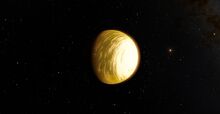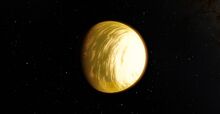NOTICE: This page will eventually be remade by SpaceGeorge. The content of this page is here for reference. It may not reflect the redone version of this page.
Overview[]
A world of humid swamps, grasslands and valleys, Delva truly is a fascinating place with its green skies, strange plants and picturesque hills.
Description[]
Delva is the third planet orbiting Nar'taxis A, the larger red dwarf of the Nar'taxis binary system. It has a massive hurricane on the daytime side as it is tidally locked. The night side is a large frozen ice sheet with a few volcanoes here and there. Four asteroid moons orbit around Delva.
Life[]
Delva is home to numerous lifeforms with the dominant species being the Delvans. Most of Delva’s wildlife resides in its oceans with the exception of some land dwelling species such as Voracias, Wods, Grottels and a species of large amphibious reptiles to name a few
The most dangerous species on Delva are the Voracias, large, predatory flightless avians that roam the countrysides, mainly preying on Grottels.
A species of large amphibious reptiles live in more humid regions further into the daytime side. These reptiles are quadrupeds and have one eye on the top of their heads.
Culture[]
Delvans are a friendly race and are naturally a pacifistic species. They used to be a tribal species who worshipped Nar’taxis A as their god. At the time, Nar’taxis translated to “Ever Watcher”.
The Delvans live in small hi-tech cities near the day-night terminator. They have also taken advantage of their planet’s tidal locking by establishing solar power stations in the eye of the hurricane, giving them access to near unlimited energy. Once enough is collected, it is transmitted via satellites to cities on the night side.
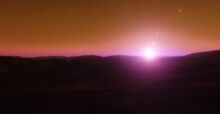
The twilight zone of Delva. Nar'taxis A eternally lies low on the horizon in this area.
History[]
It is theorized that Delva once had a normal rotation however, impacts from asteroids or a previous moon likely halted its rotation, causing Delva to tidally lock. This also caused a major extinction event and overtime, a massive hurricane formed due to high pressure in the air above tropical seas on the daytime side. The reason for believing this is because of the enormous impact craters found on the Day side beneath the seas.
Gallery[]
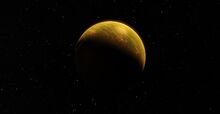

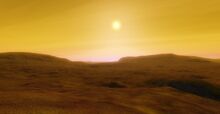

A beach on Delva.
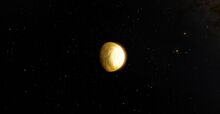
First photo of Delva, taken by the Frontier probe.
